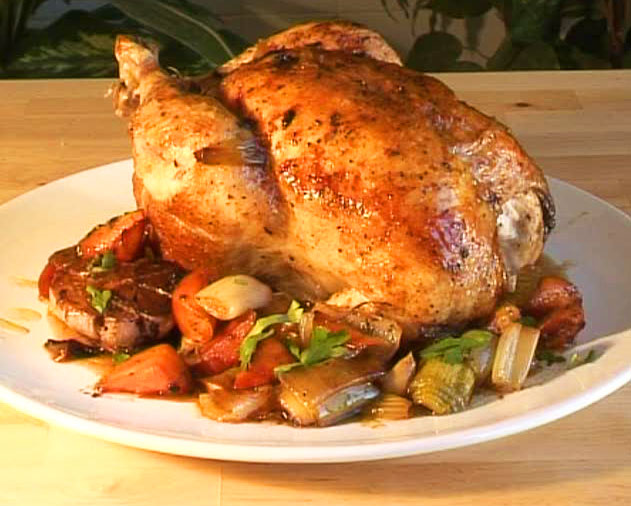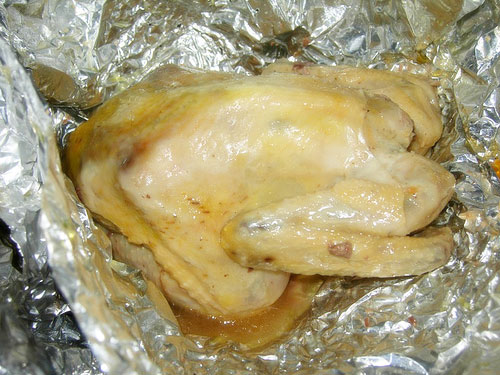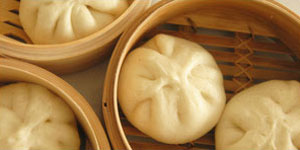 A Happy Chook is a Tasty Chook!
A Happy Chook is a Tasty Chook!
There was a time and not that long ago; Singaporeans ate nothing but firm, meaty and flavoursome Kampung chicken. That is the French breed of chicken acquiring the name Kampung, with its orange feathers and black head, commonplace roaming around Malay villages – a true free-range, happy chook.
The Kampung chicken is still around although highly unlikely to be free-range in the Singapore supply chain and presumably a cellmate with the more common battery-reared white feathered hen.
*Art work on right by Carla Barrett
The debate on the merits of free range and organic chickens as opposed to intensive-factory-farming has livened up considerably recently, particularly in the UK where celebrity chef, Jamie Olivier, has outspokenly denounced industrial-battery-raised chickens. Consequently demand in UK supermarkets for free-range birds has soared with a pervasive awareness of the negative aspects of intensive chicken farming both in the suffering of the birds and the inadequate quality of the meat.
Whilst the appalling if not macabre living conditions the poultry endure in battery farming is an emotive issue, of greater concern is the chickens are unnaturally bred to grow more quickly exacerbated by the use of large quantities of antibiotics or concoctions of immunization drugs to supplement inherently weak immune systems and combat the rampant spread of diseases in overcrowded conditions.
Of equal concern is the unnatural ground-up mash that the chickens are feed, modified so the chickens can digest in their state of confinement and laced with synthetic vitamins to replace the lack of connatural organic vitamins that would otherwise occur naturally given ample space, fresh air and most crucially, sunlight, to facilitate essential vitamin D. Then there are the issues of chemical residuals from artificial fertilizers and systemic pesticides as invariably none of the feeds will be from organic sources.
It is, important however not to be drawn in to the misinformation of chickens containing hormones which technically has been banned in poultry since 1959. Unfortunately this mistruth has been distorted by marketers and an ill-informed consumer.
The bottom line is intensive-farmed chickens grow at an unnatural pace in an extraneous environment of artificial lighting, growth-promoting antibiotic-laced feed resulting in mediocre meat quality and simply taste bland. On the other hand, the principal ideologies of free-range poultry and organic farming are built on positive health and naturally immune birds, with restricted use of medicines and free from any artificial fertilizers and pesticides.
All the evidence points towards happier chooks are tastier chooks.
I know scores of people in Singapore who advocate free-range chickens and yet, sourcing a freshly-chilled free-range, that is not frozen, is difficult and almost exclusively through a few USA suppliers, only available frozen and are prohibitively expensive to which one can only assume have been air-freighted or sailed first-class and assuredly have a high carbon foot-print.
Alas, the recent appearance of the Empress Chicken in Singapore is of significant importance and whilst not organic in the strictest sense, does enjoy a Japanese invented specially formulated organic feed and healthy antibiotic-free diet with no preservatives or residual pesticides and synthetic fertilizers.
Whilst not strictly free-range in the sense of outdoors feeding on all those wonderfully wholesome grubs, insects and grass, Empress Chickens are raised indoors in a clean, controlled environment.
It is the lactobacillus diet of the Empress Chicken that is innovative. Essentially a fermented natural feed drawing on similar ideologies of silage (anaerobic fermentation of field crops) used for cows, containing friendly bacteria combating harmful bacteria, thus strengthening the birds immune system without the need for antibiotics.
Being a relatively smaller female bird (only female’s are chosen for theirs are more tender & juicier meat) averaging around 1 kilogram and grown at a natural pace reaching full development around 35-36 days (as opposed to 30 days for intensive-farmed birds), Empress Chicken’s nutritionally and environmentally healthy disposition results in higher levels of amino acids particularly glutamine, a naturally occurring non-essential amino acid that crosses the blood-brain barrier – you could say brain food – as well as boosting digestive enzymes and aiding immune functions.
There are also significantly higher levels of tryptophan in Empress Chickens, an essential amino acid, essential meaning it is essential to humans existence and is not synthesized by the body, therefore must be acquired through ones diet. Tryptophan is also vital to the process of cells building protein and dietary proteins as well as another ‘brain-food’ being a precursor in producing serotonin.
I think we can all relate to the restorative attributes of chicken soup, mandatory in illness or recovering from surgery, as well as the overall low-fat dietary advantages of chicken. And yet, we are blasé about the quality of the bird itself moreover, averse to paying for quality and a healthier, tastier chicken. What price do we put on our health moreover, our children’s future health?
Of equal importance is they are farmed in Malaysia thus eliminating costly air-freighting and reducing the all-important carbon footprint, notwithstanding delivery a high-quality, tasty chicken at a very reasonable price. Huber’s sell a whole bird marketed under the ‘The Empress Chicken’ label for $16.95 / kg for a bird weighing an average of 1 kilogram. This is incredibly good value when you consider this will feed two adults and two young children amply. They are available on Wednesday’s (until sold out) freshly-chilled, either as a whole bird or cuts of breast and thigh meat or legs. They are frozen at all times to which I always have a least two in my freezer at all times. (Applicable for the Bukit Timah branch).
Now that you are assuredly convinced you should be eating Empress Chicken, here are two options for cooking:

Roast Chicken
I think there is no better way of enhancing the natural flavours of chicken than simple roasting. And simple means no elaborate stuffing of the bird or over doing the herbs and spices.
Weighing in at around 1 kilo this is also a relatively quick exercise requiring around 45 to 60 minutes. After washing the chicken inside and out and patting dry with paper towel, I like to rub the bird with lemon – chop in half and squeeze as you rub the chicken, again inside and out. Repeat the same procedure with olive oil and salt (I use Lake Salt), and then place the two halves of lemon in the cavity.
For a subtle herb flavour that is synergistic with the lemon aromas and the wine I have chosen as the ‘perfect match’, Pieropan Soave, you can use a little fresh tarragon and sage, placed in the cavity of the bird and tuck some under the skin of the breast and thighs.
Preheat oven to 180 degrees Celsius, maintaining this temperature for the first 15 minutes to achieve a golden brown colour and seal in the flavour, reducing to 150 degrees Celsius for the remainder of cooking time. It pays to have a separate oven thermometer as every oven has its own quirkiness, i.e. don’t just rely on the dial.
The Empress Chicken has much less fat than your pedestrian battery-raised bird, clearly another benefit, but does mean you need to baste every 10 to 15 minutes and only use olive oil. As with all cooking of poultry or meat, the all important phase is to leave it to rest for a pro-longed period, in this case a minimum of 20 minutes covered loosely with a sheet of tinfoil if you prefer to serve it warmer.
Roast vegetables obviously accompany well. I like to use a mixture of sweet potato and kipfler potato (another annoyingly difficult to find produce in Singapore; thankfully Huber’s have them regularly), along with pumpkin or carrots. Also, roasted beetroot is excellent however, be sure to put them in early and cut smaller as they will take a good hour to cook.

Chinese Salty Chicken
For something a little more challenging although still relatively simple and with an Asian flavour, chicken cooked in rock salt. This is a recipe I have learnt from my mother-in-law in Ipoh, Malaysia and a local favourite. It requires some foraging for ingredients for the local Chinese shop and herbalist, and you need a decent wok or heavy cast iron pot.
The essential provisions you need to procure from the Chinese shop are rock salt (plenty, like 4 kilos or more, don’t worry, its inexpensive) and rice (cooking) paper. Then head to the Chinese herbalist or medicine shop and ask for some dried Dong Quai, which is basically female ginseng, indigenous to China and often used in woman’s restorative remedies.
Back in the kitchen, fire up your wok (if on the stove a wok ring is imperative) or pot and fill with rock salt, heating up the rock salt until almost smoking hot (you will need a wok cover to achieve this). Prior to this, prepare the chicken using the same process as outlined with roasting, e.g. rub with lemon, then olive oil and salt, inside and out.
Then place three or four slices of the Dong Quai inside the cavity; do not overdo as it is quite strong with a pungency that can dominate. Tie up or skewer the carcass opening.
Now wrap the chicken in a double layer of rice paper (oven cooking paper) fashioning a completely sealed parcel. Completely bury the chicken parcel in the rock salt ensuring there is rock salt at the bottom and covering the bird; cover with lid reducing the gas flame to low. Leave for around 40 minutes, with the caveat this is not an exact science with variables such as wok/pot heat retention (some are more solid than others), rock salt quality and slight variance of bird size. You simply have to be prepared to experiment a little, but that’s it folks – about as simple as it gets really!
As usual, allow the bird to rest but open up the rice paper allowing the steam to escape otherwise it will continue cooking and over-cook. Indeed, steaming is essentially what has occurred here but in its own juices and you cannot get a more healthy way to eat a healthy chook. The meat is so tender that it practically melts in the mouth and whilst it is hard to accurately describe the exact flavours that the Dong Quai infuses in the chicken, there is a slightly bitter aroma, subtle sea spray, hints of chalkiness and faint citrus sweetness. Hence, you will see how the crisp, cleanness and citrus flavours, and relative austerity of the Pieropan Soave going so well with this dish.
Keeping it simple, I serve this with steamed basmati rice and some Bok Choy wok or pan-fired with some garlic. You can also serve this as an entree, practically on its own, or with a fresh young ginger and garlic sauce (as they do with Hainanese Chicken). I have also experimented with baby cucumbers cold-soaked in Sake, which worked brilliantly, of course with a shot of the said Sake served up. Maybe it was the few slugs while I was cooking that improved things!
I think this is a marvellous dish to impress your dinner guests. Wheel them in to the kitchen when the chook is in the wok and they will assume you have undertaken some great culinary feat but in reality it has been relatively easy.
(On to the wine, finally! I am sure many of you will be sceptical at the very mention of Soave (pronounced swah-veh), such is the stigma of this region. Dominated by cooperatives that control around 85 percent of total production, the emphasis has been on quantity rather than qualityproducing thin, neutral supermarket quaffing wines. Pieropan however, is a typical and without question the benchmark of the region. Indeed, it is my Italian white wine of the year, and could easily qualify as wine of the decades as the 2007 vintage is Leonildo Pieropan’s 40th vintage. I would unequivocally say he has not missed a beat in all those year, over-delivery consistently and bringing respectability to Soave. As always, a no-compromise approach succeeds where other producers fall short; to read more on Pieropan and Soave. Also visit www.pieropan.it
 Tasting note on Pieropan Soave Classico 2007
Tasting note on Pieropan Soave Classico 2007
Made from the indigenous white grape varieties Garganega (90%) and Trebbiano di Soave (10%)
Redolent of freshly squeezed oranges, white peach and ripe pear, indicative of the wines succulence; secondary complexities of olive oil scents, a subtle nutty lees character, hint of musk and underlying pungency with steely-minerally nuances.
Bracingly tart and tangy lemony palate entry but building quickly in juiciness and saturating the mouth with pomelo and grapefruit succulence, intriguing chrysanthemum tea flavours, gorgeous slippery texture soft yet supported by piquant acidity and a tantalizing white pepper and wasabi like spiciness.
Dangerously drinkable with a freshness and backbone that will deliver a palate cleansing mouthful with practically any spicy or oily food – the sort of wine you do not tire from, perfect for tropical climates, every sip mouth-watering and invigorating and so Italian; smiling and jovial yet deeply complex and hankering for food.
It is extraordinarily good value, indeed it is mindboggling how a wine of such high quality and great individual character. It reminds me of a prominent USA wine merchant commenting, “If you can’t pronounce it, it’s invariably good value”.
Retail Price: SGD$36 per bottle. Available at Huber’s Butchery
|
|
Tweet |






No comments to Empress Chicken paired with Pieropan Soave Classico 2007 | Comments Feed
No comments yet
The comments are closed.